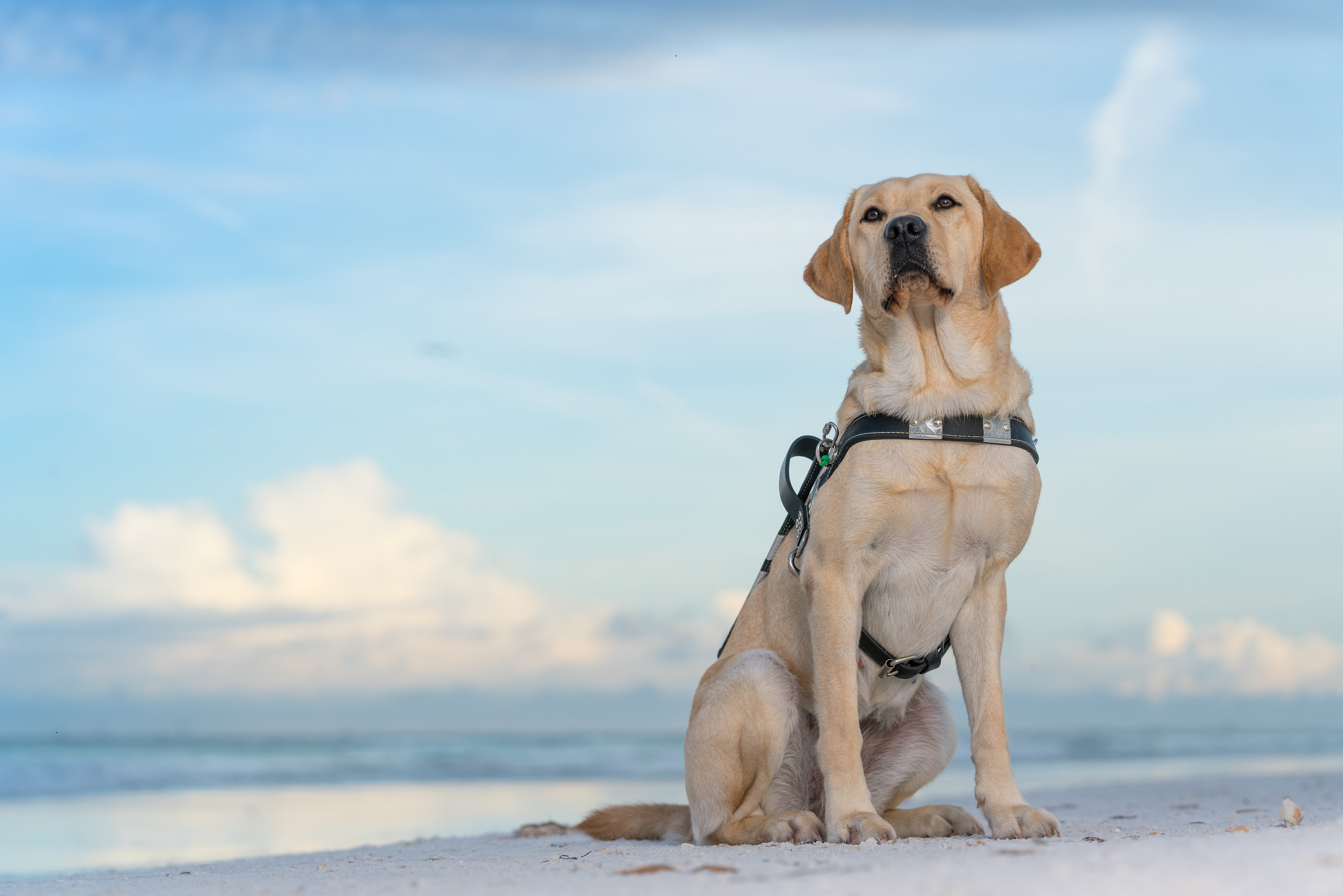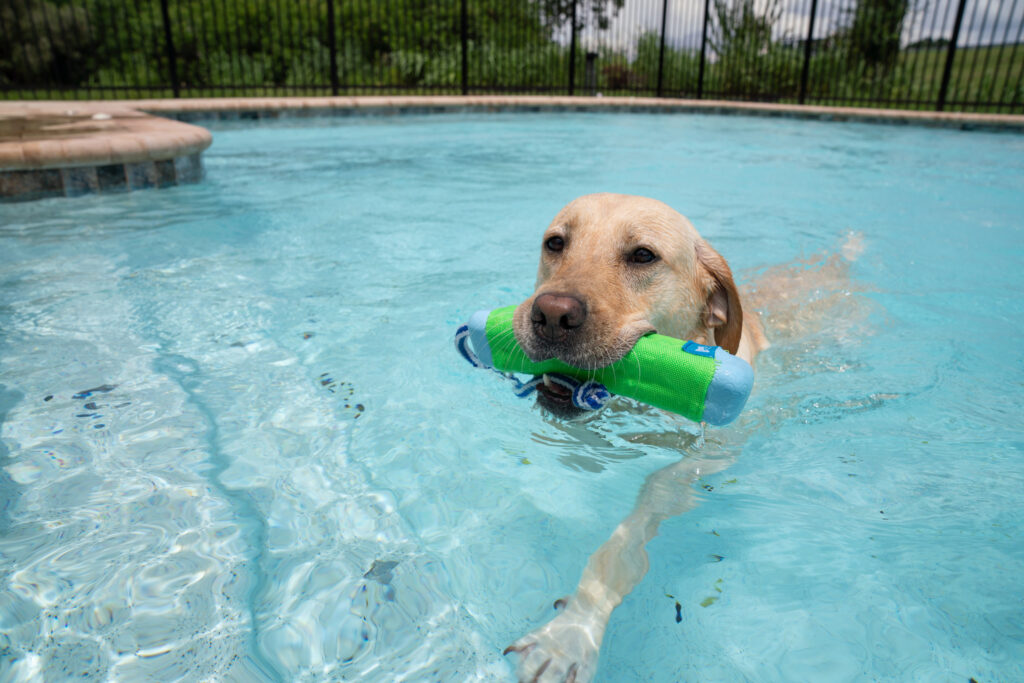
Summer Heat and Your Dog
6 Ways to Keep Your Dog Safe in the Summer Heat

How Do Heat and Humidity Affect Dogs?
Summer is here! As the temperatures rise, it is important to monitor your dog’s health and behavior. Take time to think about your dog’s safety. Sunshine, warmth, and fun times with furry friends are all great. But it’s essential to keep your beloved canine cool and happy during sizzling summer days outdoors.
Our expert instructors at Southeastern Guide Dogs Inc understand the unique toll that summer heat has on your dog—especially on steamy days when the humidity and heat index are high. The guide, service, and skilled companion dogs in their care aren’t the only canines at risk of great harm—even death—in dangerously hot conditions. Keeping your dog safe in summer is no joke.
Heat exhaustion is one of the risks your dog faces in a hot environment. Be aware of the symptoms that could progress from heat exhaustion to heat stroke.
Q1: How do I know if my dog has heat exhaustion?
Heat exhaustion (body temperature of 104° to an ambient temperature of 106°) can be serious and has the potential to progress to heat stroke (body temperature of 106°), but there are many warning signs that your dog is getting overheated. Early warning signs include restlessness, heavy panting, vomiting, diarrhea, increased respiration, heart rate, and salivation. In more advanced stages, your dog may become weak and seem to stagger. It may gasp or wheeze, and its gum color will become progressively darker.
Q2: What is dog heat stroke?
Even more dangerous than heat exhaustion, heat stroke in dogs can indicate a serious medical problem and cause invisible complications, such as swelling of the brain, kidney failure, intestinal bleeding, and abnormal blood clotting. Get your dog to a veterinarian immediately if you see these signs:
- Temperature above 106°
- Heavy panting and difficulty breathing
- Excessive drooling
- The dog appears lethargic, drowsy, or uncoordinated
- Collapse
- Vomiting
Advanced hyperthermia, or heat stroke, can lead to seizures, coma, and subsequent death.

Q3: What can you do to prevent heat stroke and other complications for your dog?
Heat stroke is a serious problem, but there are lots of ways to make sure this does not happen to your dog. Follow these summer safety tips for dogs to keep all the heat stress and sun-related dangers at bay.
- Time your walks possible, take your dog for walks in the morning or evening rather than during the heat of the day. This works for all the morning people as well as the night owls! Morning walks are a great way to start your day, anyway, and evening walks are the perfect “decompress” time. If you do need to take your dog out in the hottest part of the day, keep it short, and find shade.
- Water’s your friend you must walk a distance on hot days, be sure to bring water and give your dog frequent, brief water breaks. The key word here is brief. Allowing an overheated dog to tank up on water can increase the risk of bloat, a life-threatening condition in which the dog’s stomach twists and distends with gas.
- Walk in style If your walking routine involves long stretches of asphalt or brick, consider using mesh booties or paw wax to help protect your dog’s pads. Do not use unventilated booties since the paw pads are essential for temperature regulation.
- Beat the heat If you think your dog is becoming overheated, move into a shady area or inside a building as soon as possible. Then, cool your dog by applying cool water to your dog’s paws, belly, and inner thighs. If available, try soaking a towel in cool water and draping it over your dog’s belly. You can also spray your dog down with cool water if a hose or shower is available. It is important to use cool, not ice-cold, water.
- Take the temp possible, take your dog’s temperature rectally, and if it is above 104°F, transport the dog to the vet immediately. If you have someone with you, have them try to cool your dog while you drive. If the temperature is 104°F or less, begin cooling your dog and take the temperature every five minutes during the cooling process. Once it drops to 103°, dry your dog thoroughly and get them to the vet as soon as possible. Your vet can monitor your dog’s temperature and hydration and ensure that there are no complications.
- Check the car It should go without saying, but never, ever leave your dog unattended in a car. Traveling with dogs in the summer? Dog car safety applies to RV travel, too. Temperatures inside a car or RV can rise quickly, and leaving your dog even for a few minutes can potentially be deadly.
Bottom line?
Make summer a blast for you and your pup while keeping them safe from the dangers of the heat. Remember to stay vigilant while you’re having fun in the sun!
@seguidedogs Check out one of our newest freshmen having a blast in the pool while getting in some exercise! Swimming is a great low-impact way for dogs to stay active and healthy, and this pup clearly enjoys the pool time. 💦🐾 #YellowLab #SwimmingPup #DogExercise #StayActive ♬ Au Revoir – Sweet After Tears
Cooling off in the summer while getting fit! Watch this freshman pup at Canine University get his swim on. He’s enjoying the pool and staying safe from the heat while getting a good workout, too.
Want to learn more about our mission—or even tour our campus? Discover how our guide dogs, service dogs, and skilled companion dogs bring hope to those facing significant challenges.
You Might Also Be Interested In:
7 Ways to Prepare Your Pup for The 4th of July

